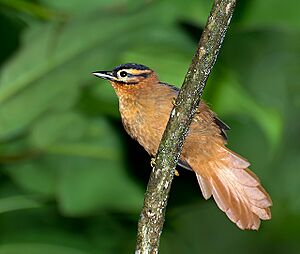Black-capped foliage-gleaner facts for kids
Quick facts for kids Black-capped foliage-gleaner |
|
|---|---|
 |
|
| At Registro, São Paulo State, Brazil | |
| Conservation status | |
| Scientific classification | |
| Genus: |
Philydor
|
| Species: |
atricapillus
|
 |
|
The black-capped foliage-gleaner is a small, active bird. It belongs to the ovenbird family, known for their unique nests. You can find this bird in parts of Argentina, Brazil, and Paraguay. Its scientific name is Philydor atricapillus.
Contents
About This Bird
What's in a Name?
The black-capped foliage-gleaner is a special type of bird. It is the only species in its group. It is also closely related to the Alagoas foliage-gleaner.
How to Spot a Black-capped Foliage-Gleaner
This bird is about 16 to 17 centimeters (6 to 7 inches) long. It weighs between 17 and 27 grams (about 0.6 to 1 ounce). Both male and female birds look the same. They have a striking face pattern.
They have a wide, pale yellow ring around their eyes. A pale yellow stripe goes over their eye, turning orange-red at the back. A dark brown band sits behind the eye. Their cheeks are pale yellow with dark brown stripes.
The top of their head is dark brown. Their back is a rich reddish-brown color. Their tail is a bright reddish-orange. Their wings are mostly brown. Their throat and chest are light reddish-orange. Their belly is also a plain dark reddish-orange.
Their eyes are brown. Their upper beak is blackish, and their lower beak is light gray. Their legs and feet are pale yellow or light olive-gray. Young birds look much like adults. However, they have dark brown edges on their belly feathers.
Where They Live
Home Sweet Home
The black-capped foliage-gleaner lives in South America. You can find it in Brazil, from Bahia south to Rio Grande do Sul. It also lives in eastern Paraguay. A small number are found in northeastern Argentina's Misiones Province.
These birds prefer tropical evergreen forests. They also live in older secondary forests. These are forests that have grown back after being cut down. They live from sea level up to about 1,000 meters (3,300 feet) high.
Bird Behavior
Staying Put
The black-capped foliage-gleaner does not migrate. It stays in the same area all year round.
What's for Dinner?
This bird eats many kinds of insects and spiders. It especially likes adult moths and butterflies. It also eats beetles and spiders. It rarely eats ants.
Black-capped foliage-gleaners often join groups of different bird species. They hunt for food at all levels of the forest. This includes the lower plants up to the very tops of the trees. They move skillfully along branches. They pick insects off leaves, bark, and cracks in the bark. They really like to find food in bromeliad plants.
Family Life
Not much is known about how these birds raise their young. Some reports say they build their nests in holes in earthen banks.
Bird Songs and Calls
The black-capped foliage-gleaner has a musical song. It sounds like a fast, whistling trill that goes down in pitch. It's a quick series of 6-8 very high notes. The first two notes are lower, and the last two are slightly lower still.
Their calls include a series of squeaky notes. They also make a "pit-wit" sound. Another call is a very high, metallic "zic" sound.
Their Status
How They Are Doing
The IUCN (International Union for Conservation of Nature) keeps track of animal populations. They first thought the black-capped foliage-gleaner was "Near Threatened" in 1988. But since 2000, they have listed it as "Least Concern." This means it is not currently at high risk of extinction.
The bird lives across a large area. However, its exact population size is unknown. Experts believe its numbers are decreasing. No immediate major threats have been found. It is considered uncommon to fairly common in Brazil. It lives in several protected areas there. In Paraguay, it is rare but found in at least two protected areas. In Argentina, it lives in Iguazú National Park.
Even though its forest home has shrunk due to cutting down trees, the bird seems to survive. It can live in small forest patches and in forests that are somewhat changed by humans.


